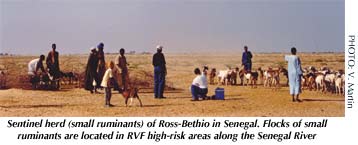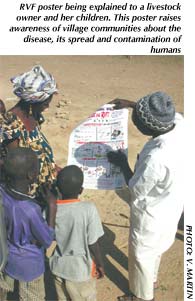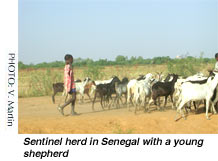


It is necessary to strengthen the surveillance of the disease at a regional level and define appropriate control strategies |
On 25 September 2003, a message of alert was sent to the members of the EMPRES discussion forum relating to an increased risk of Rift Valley fever (RVF) occurrence in West Africa, following above average rainfall during the 2003 rainy season.
 Within the framework of their regular active surveillance programme for RVF, viral circulation was detected by the veterinarian authorities of Mauritania in October 2003 in sentinel flocks located in potential high-risk areas of disease occurrence. Disease investigations were carried out in the field to define the extent of the problem and identify the clinical signs of the disease in the animal and human populations.
Within the framework of their regular active surveillance programme for RVF, viral circulation was detected by the veterinarian authorities of Mauritania in October 2003 in sentinel flocks located in potential high-risk areas of disease occurrence. Disease investigations were carried out in the field to define the extent of the problem and identify the clinical signs of the disease in the animal and human populations.
 The situation in Mauritania triggered an investigation mission to Senegal where the disease was also detected in various parts of the country, causing storms of abortion in the small ruminant population.
The situation in Mauritania triggered an investigation mission to Senegal where the disease was also detected in various parts of the country, causing storms of abortion in the small ruminant population.
Since RVF can occur in regions with similar ecosystems and the same climatic constraints, it is likely that the disease was present in other countries of the region. However, in the absence of a proper surveillance system, the disease can remain undetected or misdiagnosed for other diseases that occur under similar conditions. The importance of confirmatory diagnosis is essential in protecting the welfare of the human population and exposed animals.
 In order to mitigate the adverse effects of RVF on small ruminant production systems and on the villagers, it is necessary to strengthen the surveillance of the disease at a regional level and define appropriate control strategies. A workshop involving the different stakeholders of RVF surveillance was to be held in Dakar from 22 to 24 January 2004 to address this issue.
In order to mitigate the adverse effects of RVF on small ruminant production systems and on the villagers, it is necessary to strengthen the surveillance of the disease at a regional level and define appropriate control strategies. A workshop involving the different stakeholders of RVF surveillance was to be held in Dakar from 22 to 24 January 2004 to address this issue.